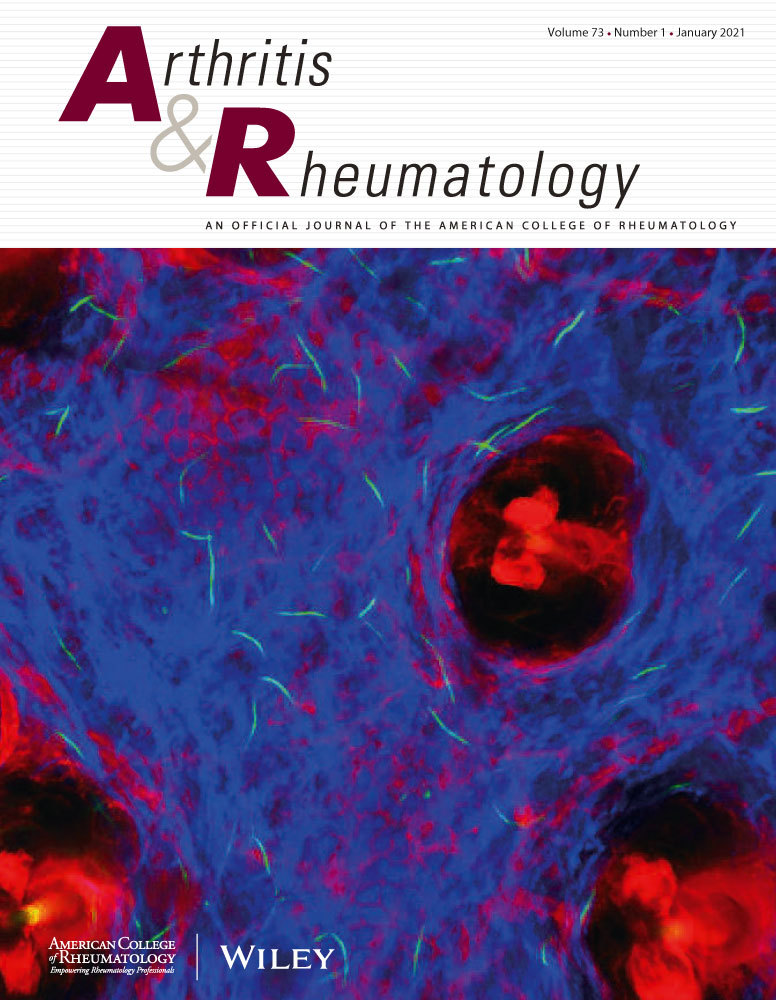Differences in IgG Sialylation Distinguish Asymptomatic from Symptomatic Anti-Nuclear Antibody Positive Individuals.
IF 10.9
1区 医学
Q1 RHEUMATOLOGY
引用次数: 0
Abstract
OBJECTIVE The transition from asymptomatic anti-nuclear antibody (ANA) positivity to systemic autoimmune rheumatic disease (SARD) is associated with increased production of pro-inflamamtory factors such as TNF-α. Here we investigate whether the relative absence of inflammation in asymptomatic ANA+ individuals (ANA+NS) results from a lack of circulating immune complexes (ICs) or from changes in the characteristics of the IgG auto-Abs produced. METHODS Flow cytometry was used to characterize circulating microparticles (MPs) in 18 healthy controls (ANA-HC), 31 ANA+NS and 51 symptomatic ANA+ patients. Differences in the ability of the total MPs, purified IgG-coated MPs, or aggregated IgG to elicit inflammation were investigated by co-culture with ANA-HC monocytes or monocyte derived dendritic cells (moDC), measuring cytokines in the supernatants. IgG sialylation was quantified by ELISA or lectin blotting using Sambucus Nigra Agglutinin, a sialic acid-binding lectin. RESULTS All ANA+ individuals had higher numbers of total and IgG-coated MPs than ANA-HC. IgG sialylation was significantly reduced in SARD compared to ANA+NS and ANA-HC, and in ANA+NS who clinically progressed in the next 2 years compared to those who did not. moDC stimulated with IgG-coated MPs or aggregated IgG from SLE patients produced significantly more TNF-α than those from ANA+NS. The levels of TNF-α produced in culture supernatants and serum demonstrated a negative correlation with IgG sialylation. CONCLUSIONS The absence of pro-inflammatory factors in ANA+NS does not result from a lack of circulating ICs, but instead may reflect differences in the extent of IgG sialylation in the ICs from ANA+NS as compared to SARD.IgG唾液酰化差异区分无症状和有症状的抗核抗体阳性个体。
目的:从无症状抗核抗体(ANA)阳性到全身性自身免疫性风湿病(SARD)的转变与促炎因子如TNF-α的产生增加有关。在这里,我们研究无症状ANA+个体(ANA+NS)炎症的相对缺失是由于缺乏循环免疫复合物(ic)还是由于IgG自身抗体特性的变化。方法采用流式细胞术检测18例健康对照(ANA- hc)、31例ANA+NS和51例症状性ANA+患者的循环微粒(MPs)。通过与ANA-HC单核细胞或单核细胞衍生的树突状细胞(moDC)共培养,测量上清液中的细胞因子,研究了总MPs、纯化的IgG包被MPs或聚集的IgG引起炎症的能力差异。IgG唾液化用ELISA或凝集素印迹法测定,凝集素是一种唾液酸结合凝集素。结果所有ANA+个体的总MPs和igg包被MPs数量均高于ANA- hc。与ANA+NS和ANA- hc相比,SARD患者的IgG唾液化水平显著降低,在接下来的2年里,ANA+NS患者的IgG唾液化水平也显著降低。由SLE患者IgG包被MPs或聚集IgG刺激的moDC产生的TNF-α明显高于ANA+NS。培养上清和血清中产生的TNF-α水平与IgG唾液化呈负相关。结论ANA+NS中促炎因子的缺失并非由于循环ic的缺乏,而可能反映了ANA+NS与SARD相比ic中IgG唾液化程度的差异。
本文章由计算机程序翻译,如有差异,请以英文原文为准。
求助全文
约1分钟内获得全文
求助全文
来源期刊

Arthritis & Rheumatology
RHEUMATOLOGY-
CiteScore
20.90
自引率
3.00%
发文量
371
期刊介绍:
Arthritis & Rheumatology is the official journal of the American College of Rheumatology and focuses on the natural history, pathophysiology, treatment, and outcome of rheumatic diseases. It is a peer-reviewed publication that aims to provide the highest quality basic and clinical research in this field. The journal covers a wide range of investigative areas and also includes review articles, editorials, and educational material for researchers and clinicians. Being recognized as a leading research journal in rheumatology, Arthritis & Rheumatology serves the global community of rheumatology investigators and clinicians.
 求助内容:
求助内容: 应助结果提醒方式:
应助结果提醒方式:


